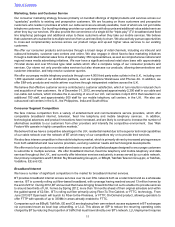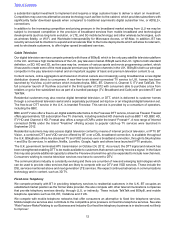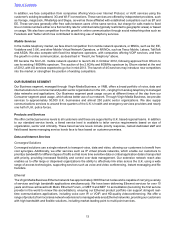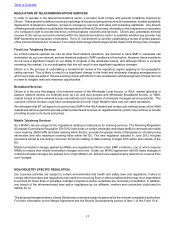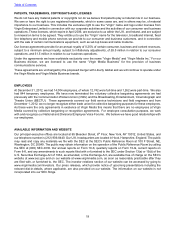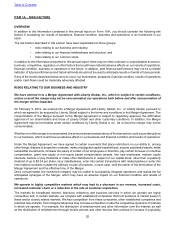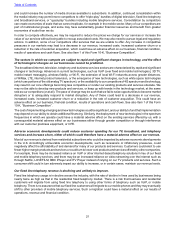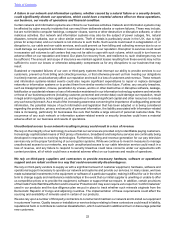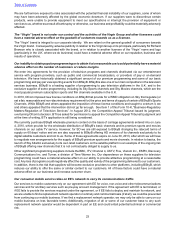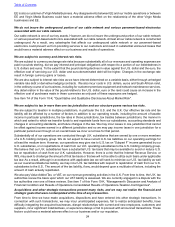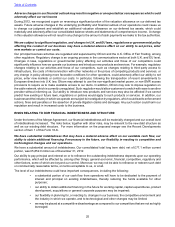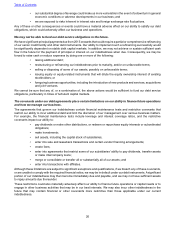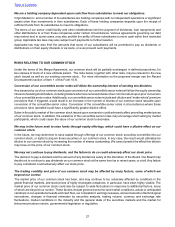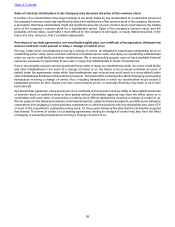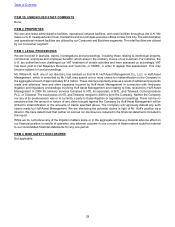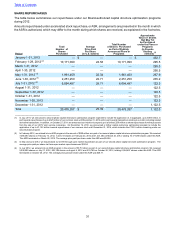Virgin Media 2012 Annual Report Download - page 22
Download and view the complete annual report
Please find page 22 of the 2012 Virgin Media annual report below. You can navigate through the pages in the report by either clicking on the pages listed below, or by using the keyword search tool below to find specific information within the annual report.
21
and could increase the number of media choices available to subscribers. In addition, continued consolidation within
the media industry may permit more competitors to offer “triple-play” bundles of digital television, fixed line telephony
and broadband services, or “quad-play” bundles including mobile telephone services. Consolidation by competitors
can create economies of scale that we cannot replicate, for example in the mobile sector. Many of our competitors are
part of multinational groups, and some may have substantially greater financial resources and benefit from greater
economies of scale than we do.
In order to compete effectively, we may be required to reduce the prices we charge for our services or increase the
value of our services without being able to recoup associated costs. We may also need to pursue legal and regulatory
actions. In addition, some of our competitors offer services that we are unable to offer. Any increase in competitive
pressures in our markets may lead to a decrease in our revenue, increased costs, increased customer churn or a
reduction in the rate of customer acquisition, which could have an adverse effect on our business, financial condition,
results of operations and cash flows. See also Item 1 of this Form 10-K, “Business-Competition”.
The sectors in which we compete are subject to rapid and significant changes in technology, and the effect
of technological changes on our businesses cannot be predicted.
The broadband internet, television, telephony and business services sectors are characterized by rapid and significant
changes in technology. Advances in current technologies, such as VoIP (over fixed and mobile technologies), 3D TV,
mobile instant messaging, wireless fidelity, or Wi-Fi, the extension of local Wi-Fi networks across greater distances,
or WiMax, LTE, internet protocol television, or the emergence of new technologies, such as white space technologies
(which use portions of the old analog TV spectrum), or the availability to our competitors of 4G spectrum and technology,
may result in our core offerings becoming less competitive or render our existing products and services obsolete. We
may not be able to develop new products and services, or keep up with trends in the technology market, at the same
rate as our competitors (or at all). The pace of change may be such that we fail to seize opportunities to become market
disrupters or to adequately respond to market disrupters. Any of these could lead to a decrease in our revenue,
increased costs, increased customer churn or a reduction in the rate of customer acquisition. This could have an
adverse effect on our business, financial condition, results of operations and cash flows. See also Item 1 of this Form
10-K, “Business-Competition”.
The cost of implementing emerging and new technologies could be significant, and our ability to fund that implementation
may depend on our ability to obtain additional financing. Similarly, the deployment of new technologies in the spectrum
frequencies in which we operate could have a material adverse effect on the existing services offered by us, with a
consequential material adverse effect on our businesses either through greater competition or through interference
with our customer premises equipment, or CPE.
Adverse economic developments could reduce customer spending for our TV, broadband, and telephony
services and increase churn, either of which could therefore have a material adverse effect on our revenue.
Most of our revenue is derived from residential subscribers who could be impacted by adverse economic developments
in the U.K. Accordingly unfavorable economic developments, such as recessions or inflationary pressures, could
negatively affect the affordability of and demand for many of our products and services. Customers could elect to use
fewer higher margin products and services or could turn to lower cost products and services offered by other companies.
For example, there may be increased reliance on VoIP or other internet-based telephony solutions in lieu of our fixed
and mobile telephony services, and there may be an increased reliance on video streaming over the internet such as
through Netflix, LOVEFILM, BBC iPlayer and ITV Player instead of relying on our TV products and services. Such a
consumer shift could in turn adversely impact our ability to increase, or in certain cases, maintain our revenue levels.
Our fixed line telephony revenue is declining and unlikely to improve.
Fixed line telephony usage is in decline across the industry, with the rate of decline in lines used by businesses being
nearly twice as high as that in the residential fixed telephony market. There is a risk that business and residential
customers will migrate from using fixed line telephony to using other forms of telephony such as VoIP, or mobile
telephony. There is no assurance that our fixed line customers will migrate to our mobile phones and they may eventually
shift to other providers of mobile telephony services. Such a migration could have a material effect on our results of
operations, revenue and financial condition.
Table of Contents


